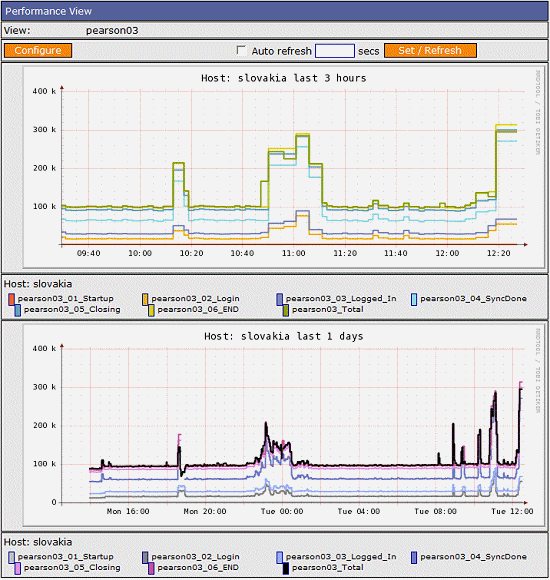|
Introduction
eValid's web rich internet application monitoring watches the performance and integrity of
your end-to-end business applications in real time.
Operating at established regular intervals 24/7, the eValid
robot test engine sends status, warnings and failure notices
to you in real time, based on the results of tests as they play back automatically.
Timely information like this alerts you to any problems in your web applications and network monitoring software
before your users experience them.
Technical Features
An eValid rich internet application monitor can simulate essentially ANY transaction
with 100% accuracy and repeatability.
- eValid test runs are state preserving (stateful) actual browser playbacks --
not HTTP-based approximations.
- Transaction is equivalent
to an actual user working with your website.
- 1-tier, 2-tier, or 3-tier application tests are available.
- eValid 3-tier application monitoring has a very low false alarm rate
(three tries are made before sending an alarm via email [to a pager]).
- Able to handle any kind of user application/interaction,
including JavaScript, ActiveX, Flash, Applets.
- Because the tests are run from a consumer-grade DSL line,
you know you get accurate "last-mile" response-time performance measurements and performance reports.
eValid Advantages
eValid monitoring playbacks are full-context,
100% Realistic Simulations
of user activities.
There's nothing "virtual" about eValid playbacks.
The
Medical Analogy
is an illustration of the differences between
eValid monitoring and "conventional monitoring"
as shown in this
Technology Level Comparison Chart.
And we have a complete description of how
eValid Monitoring Is Completely Different
from all other types of monitoring.
Setting Up Your eValid Rich Internet Application Monitoring Service
Provisioning an eValid Rich Internet Application Monitoring Service is simple.
Use the
Rich Internet Application Monitoring Request Form
to explain your needs.
Working with our monitoring support engineers
you can complete these steps:
- Tell us about your rich internet application action sequence.
- Establish the timing thresholds you want to apply.
- Establish the validation points in your application.
- Establish your email reporting requirements.
- We'll record an eValid script that follows your steps.
- Or, if you wish, we will send you a short-term eValid
key and you can record your OWN script and send it to us.
- We'll set up the script and set up your account
on our monitoring results server.
Here is a more detailed explanation of
How It Works.
Pricing & Terms of Service
eValid application monitoring is very competitively priced.
The
Rich Internet Application Monitoring Monthly Fees vary depending on the interval between tests.
Discounts for provisioning multiple monitors and for yearly pre-payments are available.
Reporting Process
Typical eValid rich internet application monitoring services report with
regular email messages (originated inside the eValid browser), and
via and account on our special Nagios-Based reporting system,
with sample performance reports as shown below.
|
|
Key Benefits
The main benefits of eValid Rich Internet Application Monitoring include the following:
| | » |
Assures delivery of high quality
e-commerce applications to your customers.
|
| » |
Three-tier architecture minimizes false-alarm rates.
You're only notified if your test fails after the third successive attempt.
|
| » |
ANY user transaction of ANY complexity can be monitored.
|
| » |
Test playback is through high-speed DSL.
|
| » |
Tests are performed with the eValid IE-compatible browser,
working with the same pages and views your customers see.
|
| » |
True "last-mile" performance measurements.
|
| » |
Rapid notification of impending trouble.
|
| » |
Complete event logging to pinpoint failures.
|
| » |
True customer-perspective performance testing.
|
| » |
Web latencies (actual delivery rates) are
included in test timings and alarm processing.
|
| » |
Application simulates real user experience.
|
| » |
Assures the quality of your E-commerce bottom line.
|
| » |
Very competitive pricing.
|
|
|
